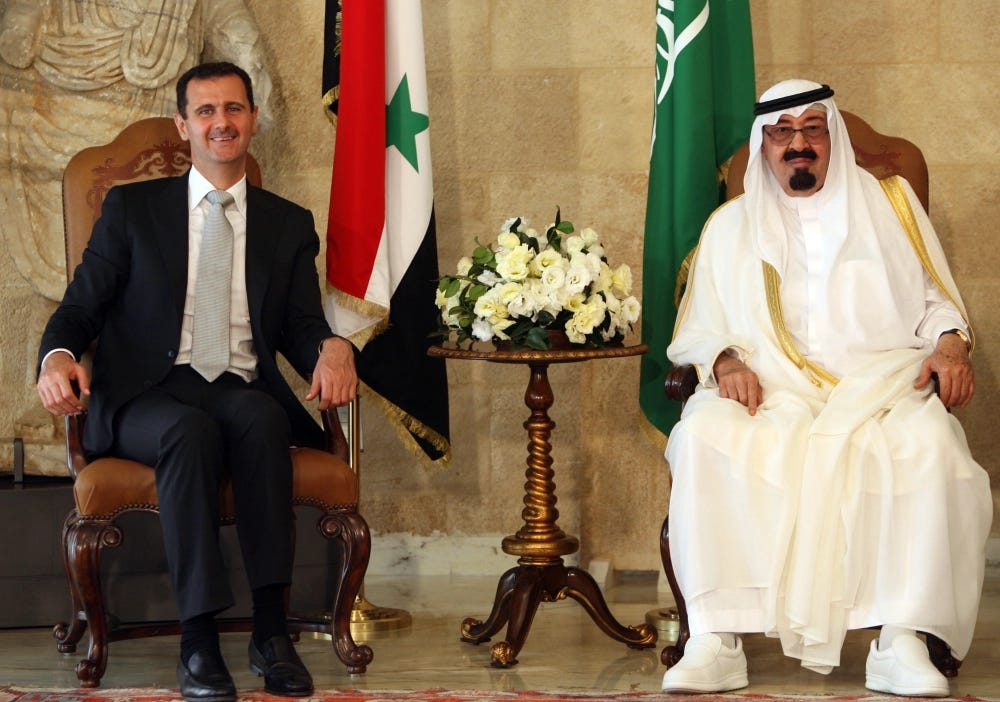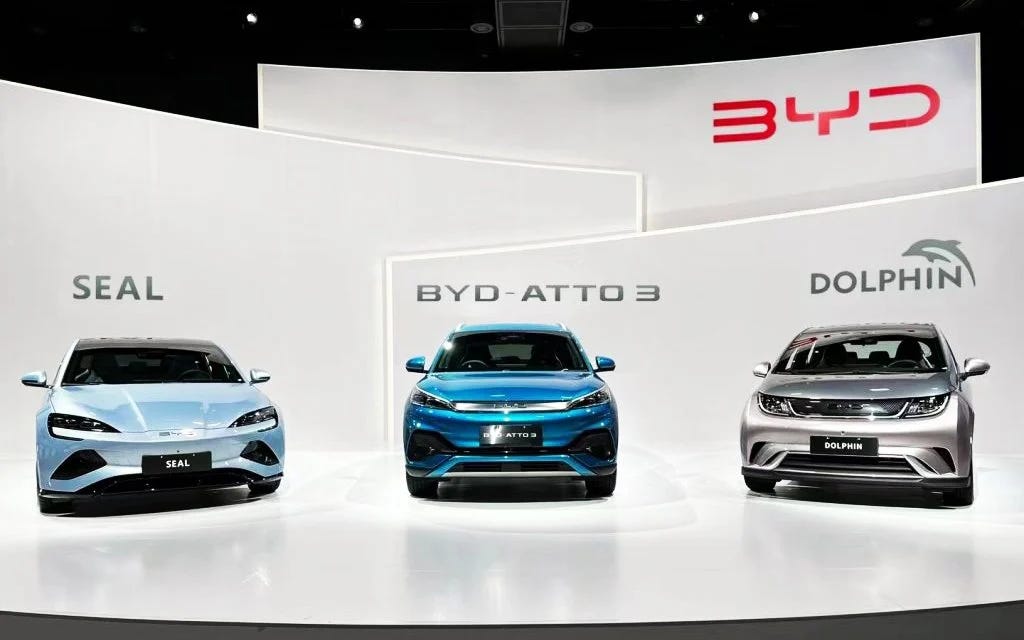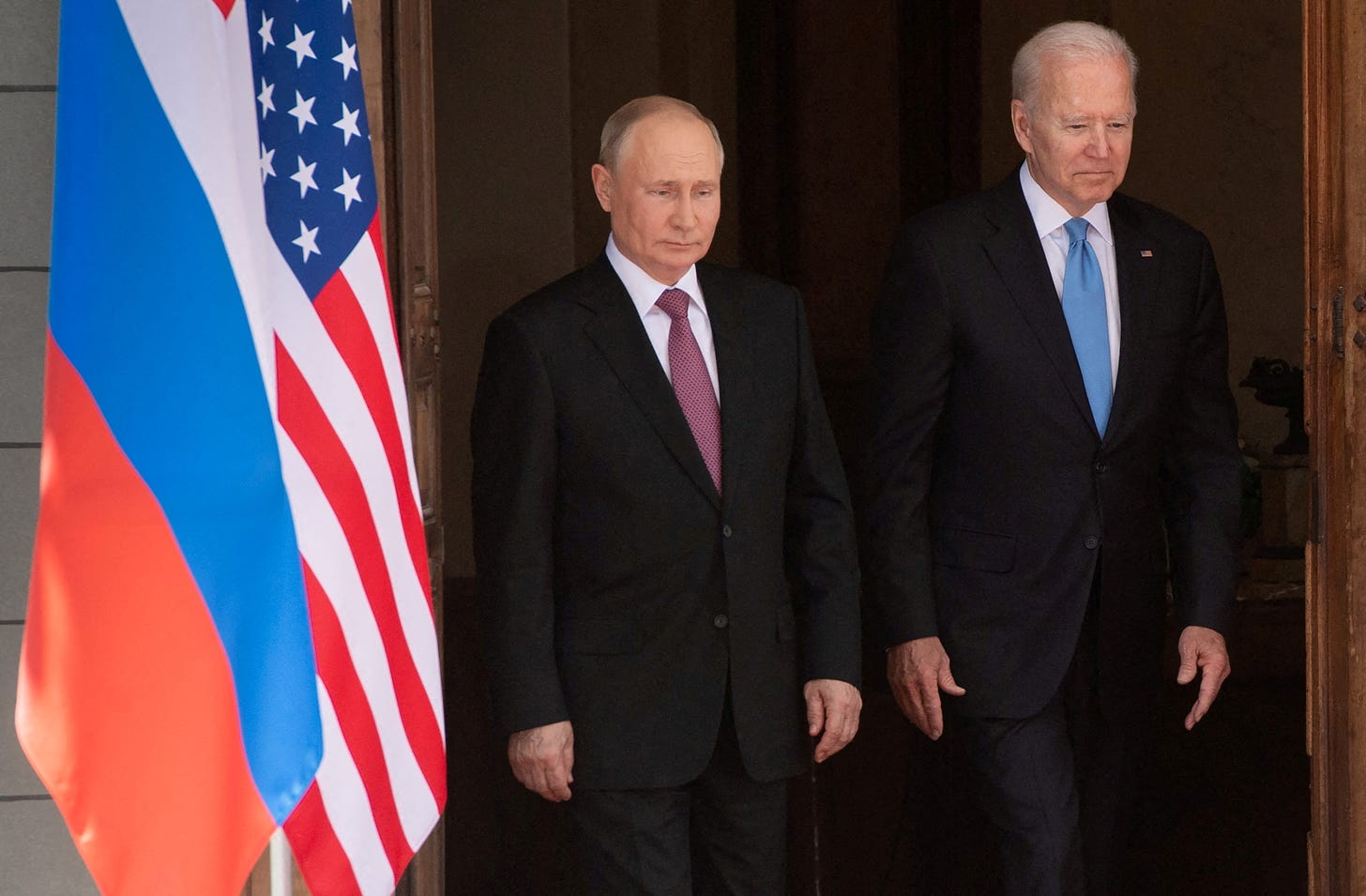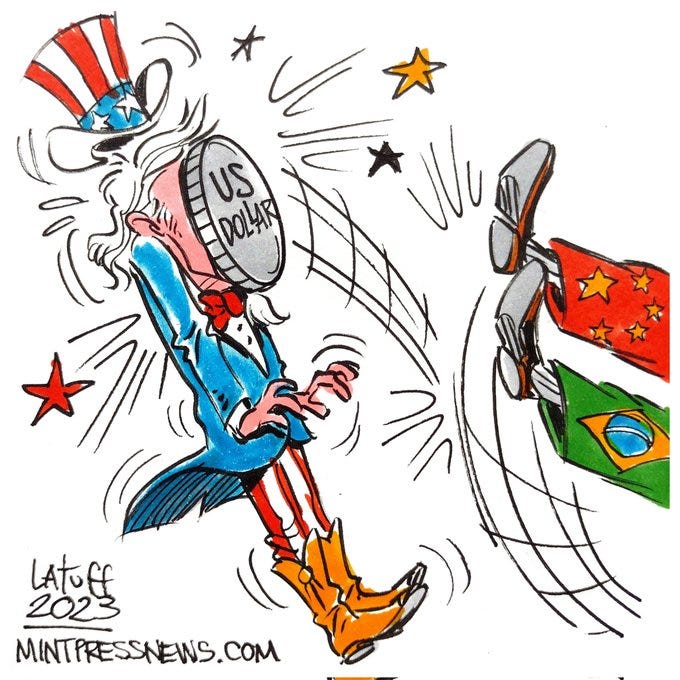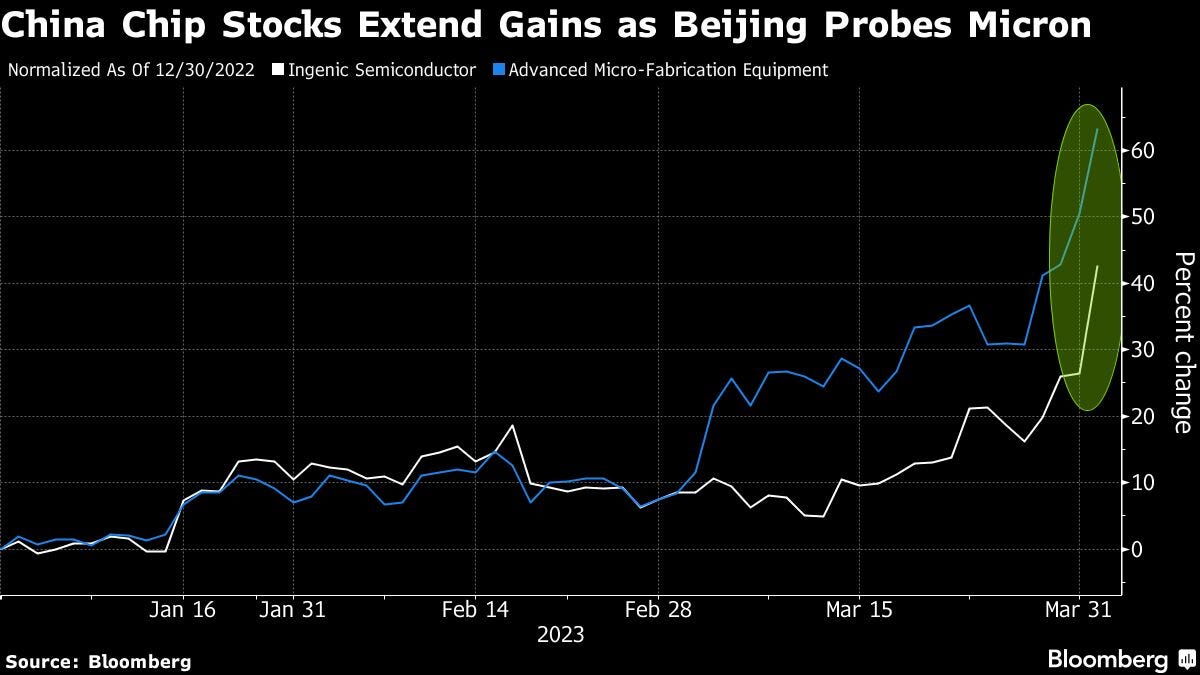G7 Godzilla
Singapore up London falls, Assad is back, US sanctions unsuccessful, China EVs kill legacy auto, Japan's G7 Godzilla, BRICS currency rise, Micron falls China Chips up
UPDATE: London has lost its sole lead as the world’s top global financial centre, according to research by the City of London that will add to concerns over the competitiveness of the Square Mile. London and New York have tied for the top spot, but Singapore has risen to third place indicating the importance of ASEAN, China and India.
Saudi Arabia is planning to invite Syrian President Bashar al-Assad to an Arab League summit that Riyadh is hosting in May, a move that would formally end Syria's regional isolation. Saudi Foreign Minister Prince Faisal bin Farhan will travel to Damascus in coming weeks to hand Assad a formal invitation to attend the summit.
As Western policymakers dig in for both a protracted conflict with Russia and an era of geopolitical great-power competition with China, they should recognize that sanctions rarely succeed in making those targets change course.
Legacy automakers are fast losing ground to China’s domestic EV car makers and are slowly but steadily getting squeezed out of the Chinese auto market. International legacy automakers have watched their share of the market shrink from 61% in 2020 to 41% in the final quarter of last year.
Japan’s break with the G7 price cap sanctions regime may signal the beginning of the end. Japan’s reliance on Russia for oil and to liquefied natural gas is a priority for Japan’s economy. This explains Tokyo’s reticence to back the G7 Ukraine proxy in its war with Russia. Japan is the only Group of Seven nation not to supply lethal weapons to Ukraine.
At the BRICS Summit in August under the South African Presidency will discuss a mechanism for transition to trade settlements in national currencies among member states. Deputy Chairman of Russia’s State Duma, Alexander Babakov, during his visit to Delhi last week reiterated the discussions will proceed.
US memory chip maker Micron Technology products are under investigation by China’s cybersecurity watchdog. China’s investigation may see Micron forced out of Chinese markets, providing more opportunities to local players including YMTC.
G7 Hiroshima!
Japan’s break with the G7 price cap sanctions regime may signal the beginning of the end. Japan’s reliance on Russia for oil and to liquefied natural gas is a priority for Japan’s economy. This explains Tokyo’s reticence to back the G7 Ukraine proxy in its war with Russia. Japan is the only Group of Seven nation not to supply lethal weapons to Ukraine.
Russia accounts for nearly one-tenth of Japan’s natural-gas imports, most of it from Sakhalin-2, and the quantity bought by Japan last year was 4.6% greater than in the previous year. An official of Japan’s Ministry of Economy, Trade and Industry said Tokyo wanted to ensure access to Sakhalin-2’s main product, natural gas, which is liquefied and shipped to Japan. “We have done this with an eye toward having a stable supply of energy for Japan,” the official said. He also said a small quantity of crude oil is extracted alongside the natural gas at Sakhalin-2 and needs to be sold to ensure liquefied natural gas, or LNG, production continues. “The price is decided by negotiations between the two parties,” he said.
The oil purchases, is a major blow to U.S.-led efforts to impose a global $60-a-barrel cap on purchases of Russian crude oil. The cap works because oil-buying nations, even if they aren’t aligned with the U.S., generally need to use insurance and other services from companies based in the U.S. or one of its allies. The G-7, the European Union and Australia have agreed to rules forbidding those companies from furnishing services if a buyer of Russian oil is paying more than $60 a barrel.
Mitsui & Co. and Mitsubishi Corp., two Japanese companies, collectively own a 22.5% stake in Sakhalin-2 and successfully pushed to maintain the stake last year with backing from Tokyo when Russia’s government under President Vladimir Putin restructured the project and installed a new Russian operator.
In the first two months of this year, Japan bought about 748,000 barrels of Russian oil for a total of ¥6.9 billion, according to official trade statistics. At the current exchange rate, that translates to $52 million, or just under $70 a barrel. Russia exports millions of barrels of oil a day, making Japan’s purchases a minuscule share of total Russian output.
Japan has almost no fossil fuel of its own and relies on imported natural gas and coal for much of its electricity. Officials have said it would be self-defeating to give up access to the Russian liquefied natural gas because Russia could turn around and sell the LNG to China.
Since the collapse of the Soviet Union, Japan has pursued energy links to Russia in part to advance its goal of recovering a group of northern islands seized by Soviet troops in 1945. The late Prime Minister Shinzo Abe met Mr. Putin more than two dozen times in hopes of reaching a territorial deal and a formal Japan-Russia peace agreement, which was never concluded after World War II.
Read more here.
London down Singapore up
London has lost its sole lead as the world’s top global financial centre, according to research by the City of London that will add to concerns over the competitiveness of the Square Mile. London and New York have tied for the top spot, but Singapore has risen to third place indicating the importance of ASEAN, China and India. This marks the first year that the UK capital has not been the clear leader as other financial centres have grown faster.
Financial services executives have warned that the UK is at risk of losing its place as a top financial centre after Brexit, which forced some companies to move operations to the EU. There are also concerns that the US is a more attractive place to list and grow businesses, given the prospect of higher valuations and a less restrictive business culture.
Chris Hayward, policy chair at the City of London Corporation, said London’s “competitive advantage is at risk”, adding: “A long-term plan to stimulate growth in the financial and professional services sector is needed.”
The City of London Corporation — which governs the area around London’s financial district — has been publishing an assessment of the competitiveness of major financial centres for three years. The City on Thursday said London received an overall competitiveness score of 60, up from 59 last year, but New York increased its score by two points to equal London. Singapore placed in third, scoring 51, while Frankfurt scored 46, Paris 43 and Tokyo 35.
The report found that the UK’s financial and professional services sector generated £64bn in trade surplus in 2022 — the largest of any country. But it also said fewer international companies were choosing to list in London, despite changes to listing rules.
Read more here.
Saudi’s invite Syria to Arab leaders summit
Saudi Arabia is planning to invite Syrian President Bashar al-Assad to an Arab League summit that Riyadh is hosting in May, three sources familiar with the plans said, a move that would formally end Syria's regional isolation. Saudi Foreign Minister Prince Faisal bin Farhan will travel to Damascus in coming weeks to hand Assad a formal invitation to attend the summit scheduled for May 19, two of the sources said.
Assad's attendance at an Arab League summit would mark the most significant development in his rehabilitation within the Arab world since 2011, when Syria was suspended from the organisation. Assad had been boycotted by many Western and Arab states over his brutal crackdown on protests - violence that led to a protracted civil war.
Arab League heavyweight Egypt has also resumed contacts with Assad. Both sides agreed to strengthen cooperation on Saturday during the first official visit by a Syrian foreign minister to Cairo in over a decade. An Egyptian security source told Reuters the visit was aimed at putting in place steps for Syria's return to the Arab League through Egyptian and Saudi mediation.
Syria's return to the 22-member body would be mostly symbolic but it reflects a change in the regional approach towards the Syrian conflict. Hundreds of thousands of people have died in the war, which drew in numerous foreign powers, and splintered the country.
Contacts between Saudi and Syrian officials gathered momentum following a landmark agreement in March between Saudi Arabia and Iran, Assad's main backer, to re-establish ties. The rapprochement between Riyadh and Tehran is part of major regional realignment, amid rising tensions between Iran and Israel.
Read more here.
China EVs displace Legacy US, EU, JP cars
Legacy automakers are fast losing ground to China’s domestic EV car makers and are slowly but steadily getting squeezed out of the Chinese auto market. International legacy automakers have watched their share of the market shrink from 61% in 2020 to 41% in the final quarter of last year. There should be a slight bounce back in the first half of this year, as these manufacturers clear out their old inventory, but BloombergNEF expects their overall share this year to be well below 50%.
There’s quite a bit of variation between legacy automakers in terms of how well they’ve fared. Toyota’s sales in China have held up reasonably well, but its Japanese peers Nissan and Honda have seen big drops in the last few years. Premium brands have generally fared better than mass market ones.
The rise of electric vehicles (EVs) is the most important factor upending the automotive pecking order in China. Automotive product planning cycles are long, and many legacy automakers misjudged how fast the Chinese market was shifting to EVs.
International legacy automakers had just 8% of China’s plug-in vehicle market in the final quarter of last year, and many of their EV offerings are not competitive with local ones in terms of the price, range and features. Their share of the Chinese EV market has steadily declined, as companies like BYD and Tesla took the initiative, and local automakers launched a flurry of electric models.
Electrification has been fastest at the top and bottom of the Chinese auto market, so the next phase of growth will have to come from the middle, where EV penetration is lower. This could bring further losses in market share for legacy automakers, unless they can quickly correct their course.
Early sales data for 2023 showed that this may already be playing out. Japanese brands were down 39% overall in January and February, while the Germans were down 21%. By contrast, BYD already sold over 300,000 vehicles in that span, up more than 70%. Founder Wang Chuanfu said last week that the company aims to be China’s top-selling automaker by the end of the year.
Other factors are also at play. In-vehicle connectivity and software offerings are often stronger from Chinese brands, and has been another point of differentiation. Chinese consumers tend to adopt new technologies faster than new-car buyers in Western markets, where the average buyer skews older.
Some of what’s happening has also been part of the Chinese government’s long-term goals for the sector for many years. Global automakers were required to produce vehicles with local joint-venture partners until very recently, a move that was designed to speed up the transfer of technology and manufacturing know-how. Electrification is now creating a lane for them to leap ahead.
It’s hard to overstate just how important China’s rise has been for global automakers over the last several decades. Indeed, much of the growth in global vehicle sales in the last 20 years has come from the expansion of China’s middle class. There’s no other growth story like China on the horizon, and with dynamics shifting quickly there now, legacy automakers are being forced into the electric age. It’s not clear if all of them will make the jump successfully.
Read more here.
US Sanctions Rarely Succeed
Over the past decade, economic sanctions emerged as Washington’s preferred policy tool to deal with adversarial governments. Sanctions became popular because officials saw them as a low-cost tool that could hurt the United States’ foes. As Western policymakers dig in for both a protracted conflict with Russia and an era of geopolitical great-power competition with China, they should recognize that sanctions can do real damage to their targets but rarely succeed in making those targets change course.
When Russian President Vladimir Putin launched its special military operation in Ukraine in February 2022, the United States and its allies slammed Russia with a raft of sanctions and other economic restrictions. But a year later, the effectiveness of these measures offers important lessons on their limits. Sanctions and export controls have been useful in undermining Russia’s financial resources and industrial base, but they have done little to change the Kremlin’s strategic calculus.
U.S. policymakers began planning major sanctions on Russia in late 2021, US officials made clear that the economic damage of an invasion would be significant, and qualitatively different from the measures that Russia faced in 2014. Once conflict began, the United States and its allies leveled sweeping sanctions on Russia’s central bank and on several of Russia’s most significant commercial banks, oligarchs, and political operatives, as well as on the country’s military-industrial complex. Moreover, the West instituted sweeping export controls to cut off Russian access to semiconductors and other key high-tech products. But by late 2022, it was increasingly apparent that Russia had weathered the initial economic storm better than many Western officials and experts had expected.
Russia’s economy proved resilient for three main reasons. First, Russia was initially able to profit off its own war. Oil and gas made up nearly half of Russia’s budget before the war, and geopolitical uncertainty surrounding the war led to high energy prices for most of 2022, allowing Russia to bolster its oil revenues by an estimated 20 percent—a significant cushion against the impacts of Western sanctions.
Second, in the years leading up to the war, Russia had worked to insulate itself from Western sanctions. Moscow withdrew its reserves from the U.S. financial system in 2018 and bolstered holdings of gold. It built domestic interbank transfer and payment mechanisms that proved successful at handling domestic payments and those between Russia and its allies. Russia deepened diplomatic relations with China, India, and countries in the Middle East, providing new outlets after trade with the West collapsed. And once sanctions were imposed, Russia adopted macroeconomic policies, such as capital controls and bailouts to firms hit by sanctions, to blunt the shock.
Third, unlike the “maximum pressure” economic warfare that the United States has waged in recent years against Iran, North Korea, and Venezuela, sanctions on Russia have been somewhat more limited in scope. Consumer goods have generally been exempt. Dozens of Russian banks remain connected to the international financial system, providing a financial conduit for trade that has not fallen under sanctions. The West has broadly refrained from introducing secondary sanctions that seek to prevent countries such as China and the United Arab Emirates from trading with Russia.
Read more here.
BRICS summit set for trade in national currencies
At the BRICS Summit in August under the South African Presidency will discuss a mechanism for transition to trade settlements in national currencies among member states. Deputy Chairman of Russia’s State Duma, Alexander Babakov, during his visit to Delhi last week reiterated the discussions will proceed.
India and Russia have put in place mechanisms of Rupee-Ruble trade. China and Brazil have launched trade in national currencies. Beijing and Brazil have signed an agreement on trade in mutual currencies. The agreement will enable the two BRICS members to conduct their massive trade and financial transactions directly, exchanging RMB Yuan for Brazilian Real and vice versa. China has been Brazil’s largest trading partner for more than a decade, with bilateral trade hitting a record US$150 billion last year.
India has also launched trade with certain other countries in national currencies. Banks from 18 countries have been permitted by the Reserve Bank of India (RBI) to open Special Vostro Rupee Accounts (SVRAs) for settling payments in Indian rupees, the government recently told the Rajya Sabha. The list comprises Botswana, Fiji, Germany, Guyana, Israel, Kenya, Malaysia, Mauritius, Myanmar, New Zealand, Oman, Russia, Seychelles, Singapore, Sri Lanka, Tanzania, Uganda, and the United Kingdom.
The ASEAN has also discussed dropping the US Dollar, Euro, Yen, and British Pound from financial transactions and instead moving to settlements in local currencies.
Meanwhile certain nations in West Asia and North Africa have expressed interest in joining the group, including Saudi Arabia and Algeria. Last year, Iran and Argentina officially applied to join BRICS.
Last month, South African Foreign Minister Naledi Pandor revealed that global interest in BRICS is “huge,” adding that she had 12 letters from interested countries on her desk, including the UAE, Egypt, Argentina, Mexico, and Nigeria. BRICS members account for more than 40 percent of the global population and around a quarter of the global GDP.
Read more here.
Micron probe by China seen as chip war retaliation
US memory chip maker Micron Technology products are under investigation by China’s cybersecurity watchdog. China’s investigation may see Micron forced out of Chinese markets, providing more opportunities to local players including YMTC.
Cheng Qian, a Chinese IT writer, notes that a patent lawsuit filed by Micron against CXMT, a Hefei-based DRAM maker, in 2018 also led to the later US decision to ban the export of 18nm or more advanced DRAM chips to China. He says that, over the past five years, Micron is on record as having lobbied the US government 170 times – with two thirds of the cases involving trade and intellectual property rights issues related to China.
“Micron has lobbied the US Commerce Department and the Office of the United States Trade Representative most frequently since 2018,” Cheng writes. “It is also the only US chip firm that has raised questions about China’s competition.”
A Shandong-based columnist says in an article that Micron may have persuaded Washington to add Chinese memory chip makers, including Fujian Jinhua, CXMT and YMTC, to the US entity list so that Micron can boost its global market share.
He says Micron also echoed the Biden administration’s “decoupling” policy last year by dismissing a 150-strong DRAM research team in Shanghai and luring more than 40 Chinese engineers to move to the US.
The columnist alleges that the US has stolen 140 gigabytes of data from Chinese servers that used Micron’s products in recent years and therefore it is necessary for China to investigate the US firm’s products to protect the country’s data security.
Last September, China’s National Computer Virus Emergency Response Center (CVERC) claimed that the US National Security Agency (NSA) Office of Tailored Access Operation (TAO) had used a cyberweapon known as “Suctionchar” to take control of computer servers at Northwestern Polytechnical University (NPU) in the city of Xi’an.
The CVERC claimed TAO had stolen 140 gigabytes of high-value data from China over the past few years. NPU called the police last June after it found malware and trojan viruses in its computer servers. The NSA has not responded to the accusations so far.
At the end of last year, Micron was the world’s third largest DRAM manufacturer with a market share of 23% and the world’s fifth largest NAND manufacturer with a market share of 10.7%. Last year, Micron’s revenue from China amounted to US$3.3 billion, about 11% of the company’s total revenue. The figure more than tripled from US$5.3 billion in 2016 to US$17.4 billion in 2018 before the firm had legal disputes with Chinese firms. If Micron fails to fulfill the requirements of the CAC investigation, it will have to leave the Chinese markets.
“China has a huge consumption market, as well as strong technological strength and innovative ability,” Situ writes in an article. “If the US does not respect China’s interests and dignity, the competition between China and the US will intensify and create a bigger negative impact on the global technology sector.”
Last October, Micron announced its plans to invest up to US$100 billion to build the world’s largest semiconductor foundry in New York. It will not be allowed to expand its facilities in China if it is granted US subsidies.
Read more here.






